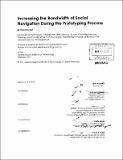Increasing the bandwidth of social navigation during the prototyping process
Author(s)
Koyrakh, Inna
DownloadFull printable version (9.941Mb)
Other Contributors
Massachusetts Institute of Technology. Dept. of Mechanical Engineering.
Advisor
Andrew Lippman.
Terms of use
Metadata
Show full item recordAbstract
Social navigation is receiving information and insight from interacting with people or observing the results of their actions. This thesis explores methods for adding social navigation to situations where it would be useful but does not arise naturally. While many researchers have explored methods for incorporating individual components of social navigation, such as sharing buying preferences, existing systems do not provide a seamless experience between the various other aspects of social navigation. In addition, these systems do not address social navigation within the context of object ecologies. In exploring these issues, we focus on how we can increase the bandwidth of social navigation to help people during the design and prototyping process. Prototyping requires one to understand core product requirements, learn new skills quickly, and make choices about materials. We identify situations where we can use technology to increase social navigation and demonstrate InfroCrumbs - a novel way of gathering relevant crumbs of information during the design process to create object use history, and share it within a prototyping environment. We suggest that such a system can be useful during the design process and that capturing object use history is beneficial.
Description
Thesis (S.M.)--Massachusetts Institute of Technology, School of Architecture and Planning, Program in Media Arts and Sciences; and, (S.M.)--Massachusetts Institute of Technology, Dept. of Mechanical Engineering, 2011. Cataloged from PDF version of thesis. Includes bibliographical references (p. 80-83).
Date issued
2011Department
Massachusetts Institute of Technology. Department of Mechanical Engineering; Program in Media Arts and Sciences (Massachusetts Institute of Technology)Publisher
Massachusetts Institute of Technology
Keywords
Architecture. Program in Media Arts and Sciences., Mechanical Engineering.